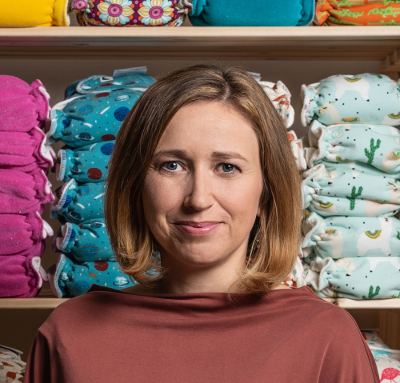You would like to try cloth period pads, but there’s still something holding you back? Might that Read more
Occasionally, when using cloth diapers, you may encounter issues that you will need help with. Our many years of experience has allowed us to get to know them in detail. We have written down the most common ones - including solutions to them, because fortunately there is always a solution.
We wish you a successful solution to all the situations that arise during your baby care, and if you come across something surprising about the diapers, don't hesitate to contact us.
Diaper leaks around the legs.
Fitted diaper leaks around the legs.
- The most common cause of this issue is that the diaper is not put on correctly. The well-chosen size, as well as the correct fit of the diaper, are key factors. Please see our video tutorials to learn how to put the diaper on a baby correctly.
- Another cause of leaking around the legs of the fitted diaper may using fleece liners, that might get clogged with either detergent or sediment, and instead of absorbing the urine, they repel it and it flows sideways where the diaper is unable to absorb everything, so it leaks out. You can prevent this by correct washing routine, as described on our article Washing cloth diapers.
Anavy Easy (all in one) or a PUL diaper cover leaks around the legs.
- When the diaper cover or All in one diaper leaks round the legs, the usual cause is that the diaper is not absorbent enough. We recommend using more inserts, changing the diaper type or changing the baby more often.
- If the diaper cover or the All in one diaper is made of PUL, you may think that the problem is due to a defect in this material. If a defect occurs, the fabric does not only leak around the legs. If a defective PUL is suspected, we recommend a simple test according to our video Damaged PUL. Leaking in the area around the groin, around legs or near velcro or snaps means that the inner diaper is too saturated. So it is really necessary to add another absorbent layer, change the type of diaper to be more absorbent or change the baby more often.
Night diaper is not absorbent enough, it does not last all night without leaking.
Onesize diaper can really be not absorbent enough for children who are drinking and peeing more or peeing during the night without waking up. In this case, we recommend purchasing XL Night Diaper. But if the onesize diaper is enough for the baby, there is no reason to buy a bulkier diaper. Night XL diaper is not suitable for babies under approx. 7 kg, as it is too bulky for them.
Hook and loop fasteners do not work any more.
They are probably clogged with deposits of detergent or hard water from washing. You can learn how to get rid of these deposits in our article What is detergent buidup and how to deal with it. To prevent your diapers from having buildup again in the future, we recommend adjusting the washing routine, see our article Washing cloth diapers.
The diapers are hard and coarse after washing.
The best solution is a dryer. If you can afford it financially or spatially, or you are not against for environmental reasons, we can only recommend. It is necessary to take into account faster wear and tear when using a dryer, therefore we recommend choosing the type of a dryer carefully (some dryers wear out the laundry excessively). Dryer-free diapers are always slightly coarser than from a dryer. The following will help to soften them:
- washing according to the instructions, i.e. enough water, non-overfilled washing machine
- correct detergent dosage - neither too much nor too little. The hardness of your water is important for the dosage.
- if you use powder detergent, try liquid. Loose powders usually leave more deposits than gels.
- using the rinse aid - the rinse removes the residue of powder and minerals from the laundry and at the same time does not reduce their absorption as if it were fabric softener.
The diapers are stinky, like a wet rag, even fresh from the wash. The diapers stinks shortly after being peed in.
- The cause may be that you overfill the washing machine so there is insufficient amount of water in the cycle, rinsing or insufficient detergent dosage, see above
- To remove the bacteria causing odor, you can use a laundry disinfectant, for example Dettol or Sanytol. You may learn on the packaging that it should be dispensed into the fabric softener compartment, but we DO NOT RECOMMEND that. Instead, we recommend adding it to the main wash cycle, in the amount indicated on the package (= one lid). This ensures that it is subsequently rinsed from the laundry and does not come into contact with the baby's skin.
TIP! Use the same "treatment" after having undergone a gut infection on all diapers.
Stains remain on the diapers.
Doporučujeme především zvážit, jestli jsou skvrny na plenách pro vás opravdu problémem. Některé se odstraňují těžko (časem samy vyblednou) a plenky nejsou svatební šaty :-) Nicméně několik tipů pro vás máme.
- Sunshine - bleaches stains from yellow yellow stool very efficiently. But try to hang the diapers so that the sun does not shine directly on the colored side of the diaper to prevent the print from fading.
- Bile Soap - apply on stains before putting the diaper in a bucket
- What NOT TO DO - bleaches (oxygen = sodium percarbonate or chlorine): never pour bleach directly onto the fabric as it may be damaged. Also never scrub the stains.
- Sometimes also changing the detergent or its dosage can help.
- Using cellulose liners that capture the stools can protect the diapers from stains as well.
If the diapers are washed correctly at 60 degrees, the stains are only dye and are hygienically harmless.
Baby has a rash after wearing a diaper with fleece.
Yes, it is possible, a small percentage of children have an allergic reaction to polyester fleece. For these kids, choose diapers that are free of fleece. Fleece liners are also not suitable for these babies.
Vinegar or acid rinse and bamboo diapers?
Some mothers use vinegar or acid rinse for softening and refreshing diapers successfully. But some are concerned that vinegar can destroy the bamboo fiber. According to our experience, you do not have to be afraid of using vinegar or acid rinse in a reasonable amount (do not put in the main wash, use the softener tray).
A test with water on a newly purchased diaper makes you feel that the diaper does not absorb enough.
Such a test is unnecessary and it is not telling you anything. Water is not urine. The only adequate absorbency test is when a baby pees in the diaper.


